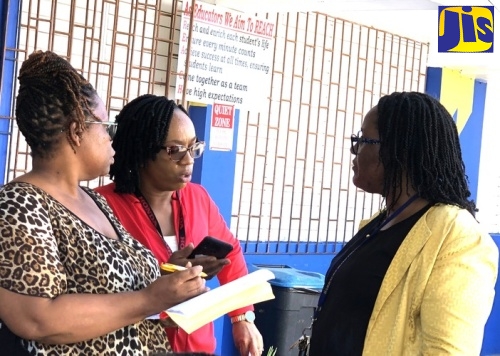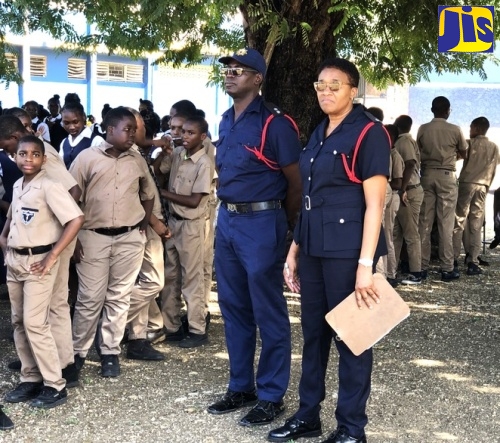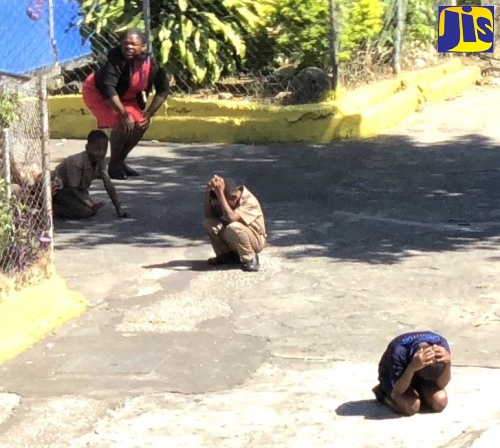Barracks Road Primary School Benefits from Earthquake Awareness Drill
By: , January 31, 2024The Full Story
The more than 1,500 students and 60 members of staff at Barracks Road Primary School in Montego Bay benefited from an earthquake awareness drill that was conducted at the institution recently as part of Earthquake Awareness Month.
At 11:50 a.m. on Wednesday, January 17, the siren sounded and staff and students put into action information imparted and practised only days before.
It was during one of their lunch breaks, but as they were advised by officers of Office of Disaster Preparedness and Emergency Management (ODPEM) St. James parish office, “earthquakes can occur at any time and without warning”.
Principal, Maxine Coates-Brown, and her Critical Incident Management (CIM) team were confident that with regular drills the entire school population would be preconditioned to respond with precision, and in the midst of “a shaking” could maintain their composure and remember to ‘Drop, Cover, and Hold On’.

Within one hour, and under the watchful eyes of Assistant Superintendent Donovan McLaren and District Officer Shayne Jones-Henry of the St James Fire Safety, Prevention and Investigation Unit of the Jamaica Fire Brigade, students and staff who were indoors, ducked under tables and desks, while others who were outside stooped and cupped their hands over their heads.
When given the signal, they then marched steadily to the assembly points on the nearby playfield.
After all were accounted for during the roll call, the buildings were checked for structural damage and, thereafter, class by class, they returned to their classrooms for debriefing.

Assistant Superintendent McLaren observed a “few glitches” but was pleased with the school’s level of preparedness.
“The teachers and students were well aware of what to do in case of an earthquake. There were a few minor glitches [such as placing] assembly points under the trees and close to the buildings. [However] the purpose of a drill is to test level of preparedness and to make the necessary corrections. No drill will be perfect. But a drill is a stress test that will make an organisation better prepared,” the firefighter concluded.
Team leaders, civics teacher Nachelle Smith, physical education teacher Michelle Humphries-Hylton, teacher Aretha Jennings, and members of the guidance counsellors corps – Patricia Mitchell-Hedley and Bernadine Reid, along with Principal Coates-Brown form the Critical Incident Management (CIM) team.
Ms. Smith explained that the mission of the exercise was to sensitise students and staff on how to respond during an earthquake and aftershocks.
“In light of the fact that [the school] experienced two earthquakes [during 2023], we didn’t want to be in the red where preparation was concerned. So we did all the necessary precautionary measures to make sure that our children are aware of what [an earthquake] is and what to expect,” she stated.
She pointed out that the students and staff were briefed on how to behave during tremors, how to recognise the sounds and warning sirens, and when to exit the building following the after-shocks.
Following the drill, Mrs. Coates-Brown and the CIM team met for a debriefing and expressed satisfaction that should an earthquake occur, the school community would respond with alacrity and precision.
“We had a few hiccups in terms of some students still having the urge to run. But I am very pleased with how they responded to the initial bell signalling that we are having an earthquake, as it relates to giving the signal that it is safe for them to leave the classroom and seeing them leaving their classrooms, being led by their teachers with registers in hand and obeying the instructions that were being given over the PA system,” Mrs. Coates-Brown said.
“I must say that they did quite well. There is room for improvement… and during the debriefing we… [looked] at the hiccups [to] see how we will remedy them,” she added.
The students were just as enthused, but even more critical of their performance.
According to head girl Samoya Rowe, the day’s activities went well.
“However, some students were running, even though they were told not to do so,” she pointed out.

The student said she intended to point this out to her peers over the forthcoming weeks, in the hope of influencing their behaviour during the next drill, whenever that takes place.
Samoya also indicated that she intends to recommend that drills be conducted regularly, noting marked improvement with each session staged.
Head boy Javaughn Beckford, who concurred, was optimistic that “we will do better with practice and confidence”, adding “next time the sprints will become a swift march”.

A common take-away from all the students interviewed was that they will become the drill masters at home to ensure that members of their families and neighbourhood are aware of how to correctly react to an earthquake and remember to Drop, Cover, and Hold on.
Barracks Road Primary, Maldon High School, Cambridge Primary School and Flanker Primary and Junior High School were the four institutions visited and assessed by the St James Division of the Jamaica Fire Brigade for the awareness exercise.




